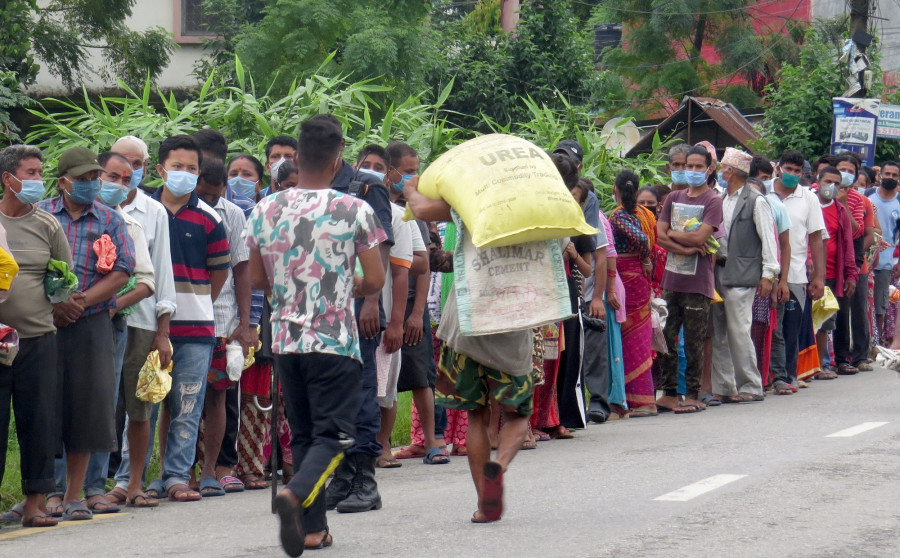National
Fertilisers not on ‘essential commodity’ list as paddy farmers wait anxiously
Decision to block supply can have an overarching effect, as it may hit paddy crop, and slash economic growth in turn.
Sangam Prasain
Every morning, farmer Dipak Bhurtel of Tilottama-6, Rupandehi in western Nepal wakes up early and customarily rings up several cooperatives and state-run depots asking if they have resumed the supply of paddy seeds and chemical fertilisers.
“Not yet,” comes the answer. Almost all districts in the country are currently under lockdown to prevent the spread of the coronavirus which has killed 7,555 Nepalis as of Wednesday.
Many farmers like Bhurtel don't know that the KP Sharma Oli administration itself has stopped the distribution of chemical fertilisers and seeds even though there are adequate stocks with the suppliers.
Experts say that blocking supply is a foolish move as it may hit paddy production, and consequently slash economic growth.
Tens of thousands of Nepali farmers are quite worried that there could be a repeat of last year's fertiliser shortage, which made them miss out on a super harvest since the monsoon rains were good and labour was plentiful, as Nepalis working in various parts of India had returned home to escape the pandemic.
But this year the shortage is not because of the unavailability of chemical fertilisers.
The Covid-19 Crisis Management Operations Centre Steering Committee, which has blanket authorisation to take measures to stop the spread of Covid-19, has removed fertiliser from the list of “essential commodities”, barring it from being transported. At the same time, farmers are confined to their homes by the lockdown.
Paddy plantation has already started in the hills and mountain regions while farmers in the Tarai have begun preparing seed beds. Normally, the paddy seedlings become ready for transplanting three weeks after sowing.
For Bhurtel, who ekes out a living from his one-bigha [0.68 hectare] field, the government decision to suspend the supply of vital inputs is like a death sentence.
"There is no fertiliser. There are no seeds. I am worried," said Bhurtel.
Paddy is planted on nearly 1.5 million hectares of land across Nepal, and it is the major source of income for around 60 percent of the population. The agriculture sector contributes 26 percent to the national gross domestic product (GDP) with paddy alone accounting for 7 percent.
Paddy transplantation begins in June when the monsoon drenches the land. Harvesting starts in November. The country’s economic growth is mostly dictated by paddy production as many Nepalis depend on agriculture for their livelihood.
Farmers suffered huge losses last year due to a shortage of fertiliser during the key transplantation period.
Bal Rai of Rohini-2 in Rupandehi is deeply distressed because of the state's inability to provide adequate and timely fertiliser to the farmers. Rai, who owns 6 bighas [4 hectare] of land, expects a rerun of last year's fiasco.
Ram Lakhan Gupta of Kothimai-1 owns a vast farm spread over 20 bighas [13.6 hectares]. And his worry is growing by the day.
"I am worried that this lockdown will put us into a deep crisis. We are again facing a shortage of fertiliser and seeds," he said. “It's not possible to go to the border markets to buy them either.”
Despite Covid-19 wreaking havoc across Nepal and India, smuggling of chemical fertiliser and paddy seeds has continued unabated, which may be bad for the state but a boon for many farmers.
Some farmers in Kapilvastu have decided to take a risk.
“They go to the bordering areas to buy contraband seeds and fertiliser. We are in deep trouble," said Kairulla Musalman of Malparwa in the district. "We know that the seeds smuggled in from India are not of good quality and are costly, but we don't have an alternative.”
The government-owned Agriculture Inputs Company office in Taulihawa stopped distributing fertilisers three weeks ago.
"It's risky to start selling fertiliser. We will be mobbed by panic-stricken farmers," said Prakash Gyawali, chief of the company’s branch office. "But we are planning to resume distribution of chemical fertiliser by following the health protocols."
Many offices in the district are waiting for the go-ahead from the headquarters.
“We have raised the issue with the Covid-19 Crisis Management Operations Centre Steering Committee several times, but we haven’t been allowed to begin the distribution,” said Shree Ram Ghimire, spokesperson for the Ministry of Agriculture and Livestock Development.
On Wednesday, local authorities in Kathmandu Valley allowed the transportation of chemical fertiliser. But there are no immediate plans to allow transportation to supply the soil nutrients to farmers in the Tarai region, the country’s food basket, according to government officials.
Ghimire said it is up to the higher authorities to decide.
Last year, the government faced massive criticism for not being able to supply enough chemical fertiliser during the peak paddy transplantation season. Despite a severe shortage of fertiliser, farmers recorded a larger harvest helped by the availability of adequate farm workers and rainfall.
The outlook for the availability of fertiliser this fiscal year ending mid-July, however, is much better, according to authorities. There are adequate stocks of the vital farm input and firm orders have been placed.
The country currently has a stock of 80,000 tonnes of fertiliser–35,000 tonnes of urea, 35,000 tonnes of diammonium phosphate (DAP) and 10,000 tonnes of potash, according to Pankaj Joshi, deputy general manager of Salt Trading Corporation, a public-private supply venture.
According to him, 60,000 tonnes of urea is on the way to Nepal.
“The requirement of urea for the paddy transplantation period stands at 110,000 tonnes based on last year’s estimate. So we are only 15,000 tonnes short,” he said, adding that the government had asked Salt Trading to expedite the process to fulfil the deficit.
The four-month-long paddy cultivation season requires 110,000 tonnes of urea and 60,000 tonnes of DAP. The country’s DAP stock currently stands at 40,000 tonnes.
“There is no issue of shortage this season. The only problem is transportation to dispatch chemical fertiliser to the farmers' doorsteps,” said Joshi. “A spike in Covid-19 caseloads had also worried transporters.”
According to Joshi, even if the government allows transportation, drivers are not willing to take the risk.
“Normally, it takes two days to deliver fertilisers, but now because of the risk factor and hassles to obtain a permit, the transportation time has increased to seven days as trucks are allowed only at night,” he said. “The state suppliers are not allowed to pay extra freight costs. So there are problems in every step.”
There, however, is no restriction on international trade movements like last year, said Joshi.
The government has allocated Rs11 billion in fertiliser subsidies for this fiscal year, up from Rs9 billion in the last fiscal year. The value of total imports of chemical fertiliser hovers around Rs19 billion annually.
According to the Agriculture Ministry, the annual demand for chemical fertiliser currently stands at more than 700,000 tonnes while official imports are just around 300,000 tonnes. Subsidised fertiliser fulfils 40 percent of the country’s total requirement while the rest is met by informal imports or shipments smuggled across the open border.
Last year, farmers encountered fertiliser shortages right from the beginning of the planting season in June. First, there was a short supply of DAP, as the Covid-19 pandemic disrupted the global production and supply chain.
Then a shortage of urea appeared during the time for the first and second top dressing. In response, the then minister for agriculture Ghanashyam Bhusal promised to bring urea from Bangladesh and requested a shipment of 50,000 tonnes.
Out of the 50,000 tonnes, the last consignment of 19,500 tonnes is expected to arrive within a few weeks.
Although the supply situation of fertiliser has been problem-free this year, there are worries about fulfilling demand next year as global prices of the vital farm inputs have hit a record high.
According to reports, prices of diammonium phosphate, the world's most widely used fertiliser, saw a steep jump in April compared to the same period last year. The global average price of diammonium phosphate in April averaged $629 per tonne, up from $413 per tonne in April last year.
The average price of urea in April was $513 per tonne in the global market, a rise from $386 in April last year,” said Joshi. “With the subsidy amount of Rs11 billion allocated for this fiscal year, the country was able to buy nearly 500,000 tonnes of chemical fertiliser.”
However, for the next fiscal year, according to Joshi, state suppliers will be able to buy only 300,000 tonnes of chemical fertiliser even though the government has increased the amount to Rs12 billion.
“So if the government does not address the issue in a timely manner, the situation could be severe in the next fiscal year,” Joshi told the Post. “But if the price of urea is increased from Rs15 per kg to Rs35 per kg, which the farmers can afford, it will ensure availability without straining the state coffers.”
Sanju Poudel in Rupandehi and Manoj Poudel in Kapilvastu contributed reporting.




 8.12°C Kathmandu
8.12°C Kathmandu















